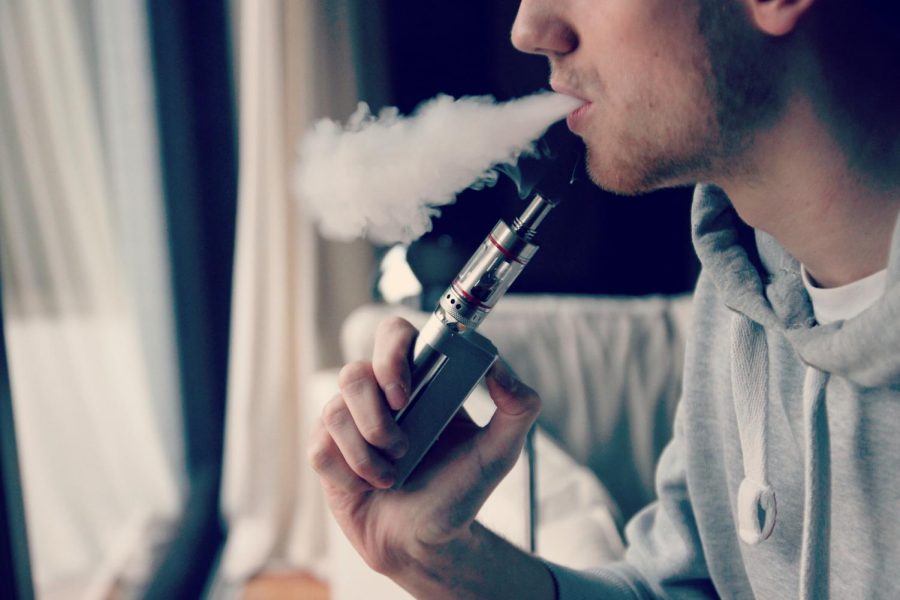Vaping is likely dangerous and it certainly isn’t cool
EDITORIAL
Google image/Creative Commons license
One fear is that vaping might make teenagers think smoking is “cool” again.
Through the power of pop culture and various forms of media, 2018 has seen the revival of certain trends from the twentieth century. Music has returned to vinyl, fashion has hints of ’90s and ’80s styles, and television shows are streaked with nostalgia and classic soundtracks.
There is one trend, however, that is proving harmful to young people across the country, even if it is guised in a slightly different form: vaping.
Perhaps the return of the perceived hint of “cool” aloofness and rebellion associated with smoking, vaping involves using a handheld electronic device to inhale heated vapor, often in sweet or savory flavors.
Middle and high school students across the country have begun to use these devices in school bathrooms, between classes, and sometimes even in lessons — and AMSA is not excluded.
While not a problem in the 6th grade, according to Dean of Students James Frier, there have been reports of “doing it in class [and] in the bathroom.”
The staff here at The AMSA Voice believes that rules and regulations aren’t going to stop this problem, and that change must come from within the student body.
“[Because of] the nature of these devices, someone who is clever knows how to [hide them easily],” Mr. Frier said.
Devices used to vape can be a subtle as a “vape pen,” which looks something like an ink pen or a thumb drive, allowing ease of access for students.
The AMSA Student-Parent Handbook already has clear rules set in place against smoking of any kind: “State law prohibits the use of any tobacco products or nicotine products, including nicotine delivery devices, e-cigarettes and vaporizers, within school buildings and facilities, or on school grounds or buses by any individual.”
“[The punishments] can be as serious as expulsion, and is typically a suspension,” Mr. Frier said.

Vaping devices can come in a variety of forms that mask what they are, including “pens” and “thumb drives.”
The consequences don’t seem to be stopping anyone. Perhaps the forbidden quality of vaping is what makes it attractive to teenagers.
“Part of the trend is the rebellious nature even though you know you can get into trouble,” Mr. Frier said.
He went on to explain that he believed another attractive feature of vaping is its electronic nature.
“A big part is that it genuinely can look pretty cool, and more appealing than cigarettes,” he said. “It is more appealing to younger kids who are into electronics and it gives the appearance of being less harmful.”
Compared to cigarettes, which have a pungent odor, vaping devices allow the user to inhale sweet, candy-smelling and -tasting liquids, appearing much less harmful than traditional tobacco products.
Although it appears less harmful, The AMSA Voice staff believes vaping is just as dangerous to teenagers as any other device for smoking.
Because it contains nicotine, an addictive alkaloid, vaping can serve as a gateway for young people to begin smoking with other devices. Vaping is often advertised as being a safe alternative to smoking, but new scientific evidence suggests otherwise.
According to Time magazine, Dr. Holly Middlekauff, a professor of medicine at UCLA, and her team have discovered that nicotine boosts “adrenaline levels in the heart — essentially putting the heart under stress […] a major risk factor for heart attack and stroke.”
In addition, PBS reports that Dr. Daniel Conklin, an environmental cardiologist, has done research that suggests the carbonyls (such as formaldehyde and acrolein) in varying and unpredictable amounts are formed through the combustion process completed in vaping.
Although the research on the effects of vaping on lungs is unclear, the American Lung Association claims it is “concerned about their impact on the public health, given the dramatic increase in use among youth.”
Despite the absence of scientific consensus, it is increasingly clear that it is not as safe as many students think — and they need either to stop or refrain from vaping for the benefit of their health.

Amelia is a senior. She has a great interest in writing and is excited to be a journalist and co-editor for the The AMSA Voice. Amelia has attended AMSA...

Emma is a senior, returning to The AMSA Voice this year as editor in chief. At AMSA, she is involved in various clubs and organizations, such as AMSA JCL,...






